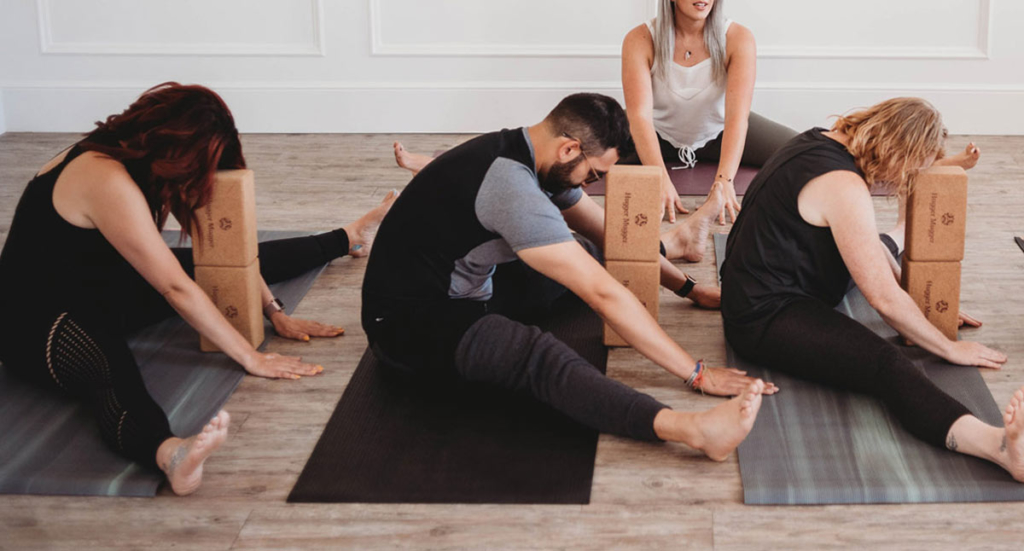
More than Muscles
In yoga classes, we hear and talk a lot about muscles. Which muscles are stretching or contracting in a certain pose, how to stretch or engage muscles, how poses effect certain muscles, etc. This is because our muscles move our bones via their paired contracting and stretching actions. But muscles are not the only structures that determine flexibility. Stretching fascia is just as important.
As a teacher, it’s essential to understand how muscles move our skeleton. Having at least a cursory understanding of the origins and insertions of the muscles that move our structure through space is important. In yoga in particular, knowing how to stretch muscles safely is essential.
The Muscle-Spindle Sensory Nerve
It takes 30 seconds of stretching for a muscle to become longer. Embedded in each muscle fiber bundle is a sensory nerve called the muscle spindle sensory nerve (MSSN). The MSSN’s job is to sense when a muscle is being stretched beyond its capacity and to send a message to the spinal cord. The spinal cord then sends an impulse through the muscle’s motor nerve that actually contracts the muscle in order to keep it from over stretching. After 30 seconds in a stretch, however, the MSSN habituates to the muscle’s new length and allows it to adjust itself to that new length.
If muscles were all that predict our flexibility, the 30-second stretch would be enough to effect powerful change. And it is certainly one component of stretching. However, anatomists, physiologists, body workers, and yoga teachers are now beginning to understand the role that fascia plays in flexibility.
What is Fascia?
Fascia is a connective tissue layer that lives virtually everywhere in the body. It covers the muscles, weaves itself into the connections between muscles and other muscles, as well as muscles and our vital organs. Until recently, fascia was something that anatomists cut away in order to get to muscles they could dissect and categorize. Now, fascia is recognized as a living organ all its own.
Ida Rolf, the creator of the body work called Rolfing Structural Integration, recognized the importance of fascia. The Rolfing method of body work is entirely focused on fascial balance and release.
Tom Myers’s 2009 book Anatomy Trains brought fascia into the limelight to wider community of body workers and movement therapists. This presented a “whole system” view of the whole-body connections among muscles within the fascial net. You can find out more about the Anatomy Trains system here.
For a look at how fascia thickens and loses pliability when you neglect it, check out this video, titled “The Fuzz Speech” by anatomist Gil Hedley. (The demonstration uses a medical cadaver, so if this sort of thing makes you queasy, this demo may not be for you.)
Fascia and the Meridian System
Of particular interest to me as a yoga teacher and practitioner, is the idea—supported by Ida Rolf and others—that the energy meridians reside in the fascia. The implications of this are staggering. This means that by tending to our fascia, we can effect change in the physical, mental/emotional, and energetic koshas.
Years ago, I heard that if you want to make a change on the physical level, you must stretch for 30 seconds—ah yes, the muscle spindle sensory nerve. If you want to effect a change on the pranic level, you must stretch for 3 to 5 minutes.
If the meridians reside in the fascia, and contracting and stretching fascia can affect the meridians, how can yoga help? This excerpt from the Running Times article suggests that slower-paced yoga styles such as Yin Yoga, Iyengar and Restorative Yoga may be effective ways to access the fascia, and therefore the profound effects of meridian work:
Stretch Your Fascia
Once your fascia has tightened up, it doesn’t want to let go. The fascia can withstand up to 2,000 pounds of pressure per square inch. So, stretch gently, you’re not going to force your way through. Fascia also works in slower cycles than muscles do, both contracting and stretching more slowly. To stretch the fascia, hold gentle stretches for three to five minutes, relaxing into a hold.
I’m just beginning to learn about fascia, but I’m very excited to explore this new physical avenue for effecting deep transformation, via stretching and stabilizing on the fascial level. Here are three warmup poses that can be especially helpful in stretching fascia.
Let’s Chat
What do you know about fascia? How does your Yoga practice support stabilizing and stretching fascia?
